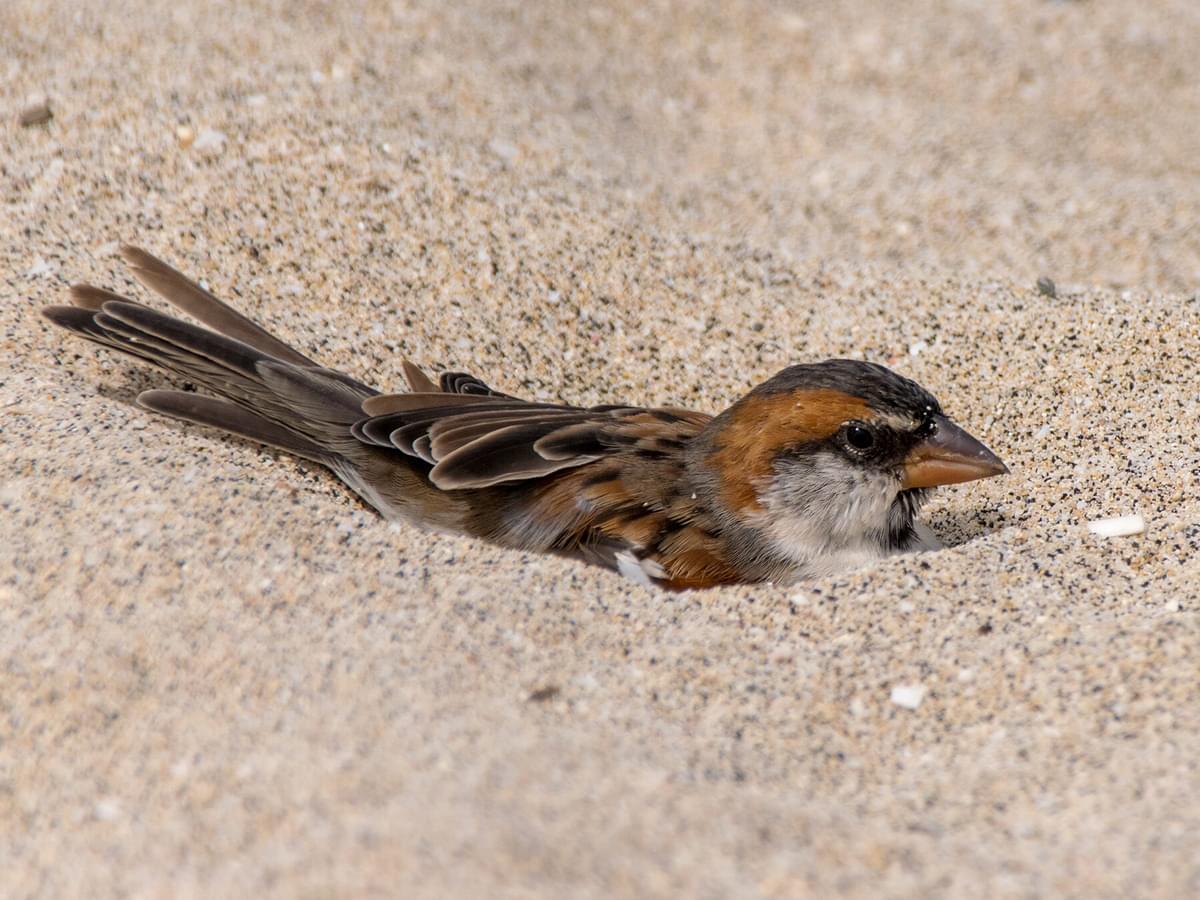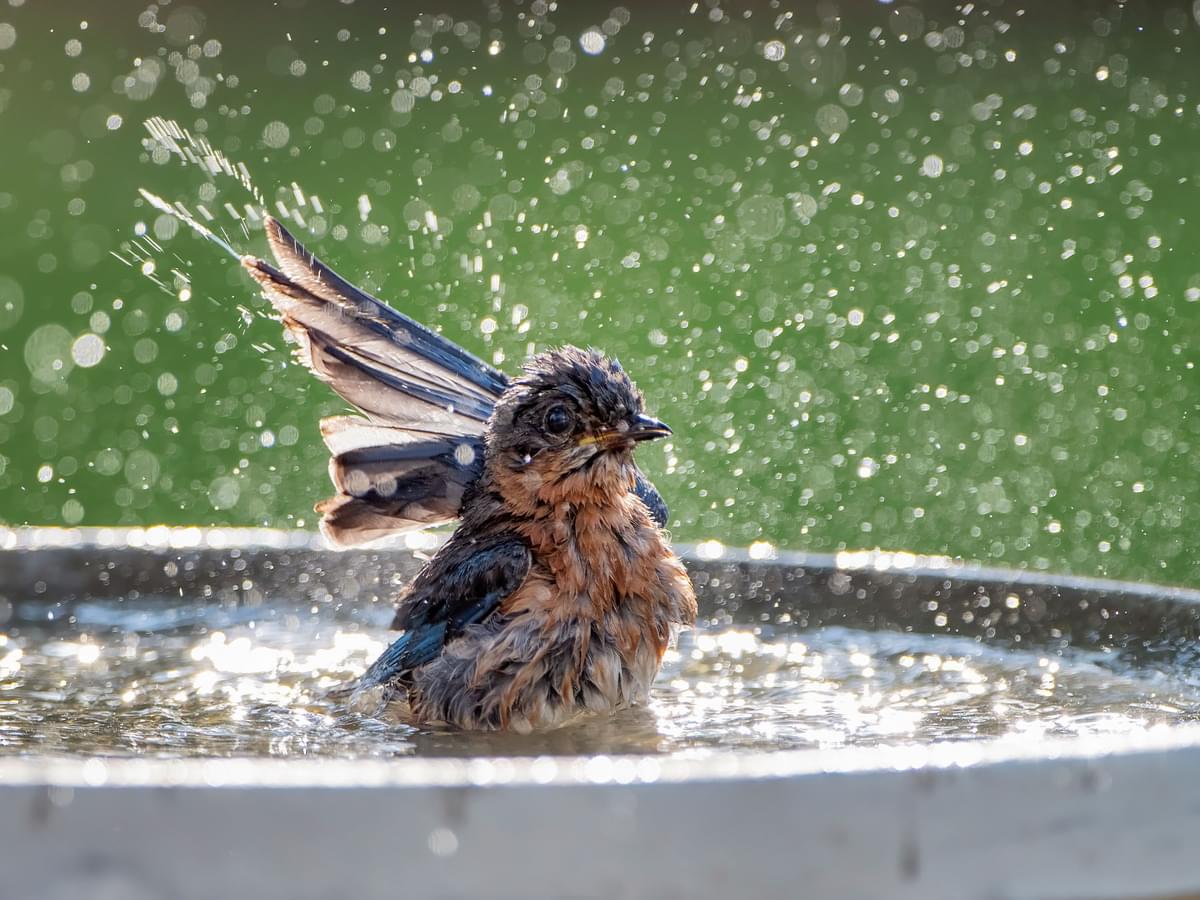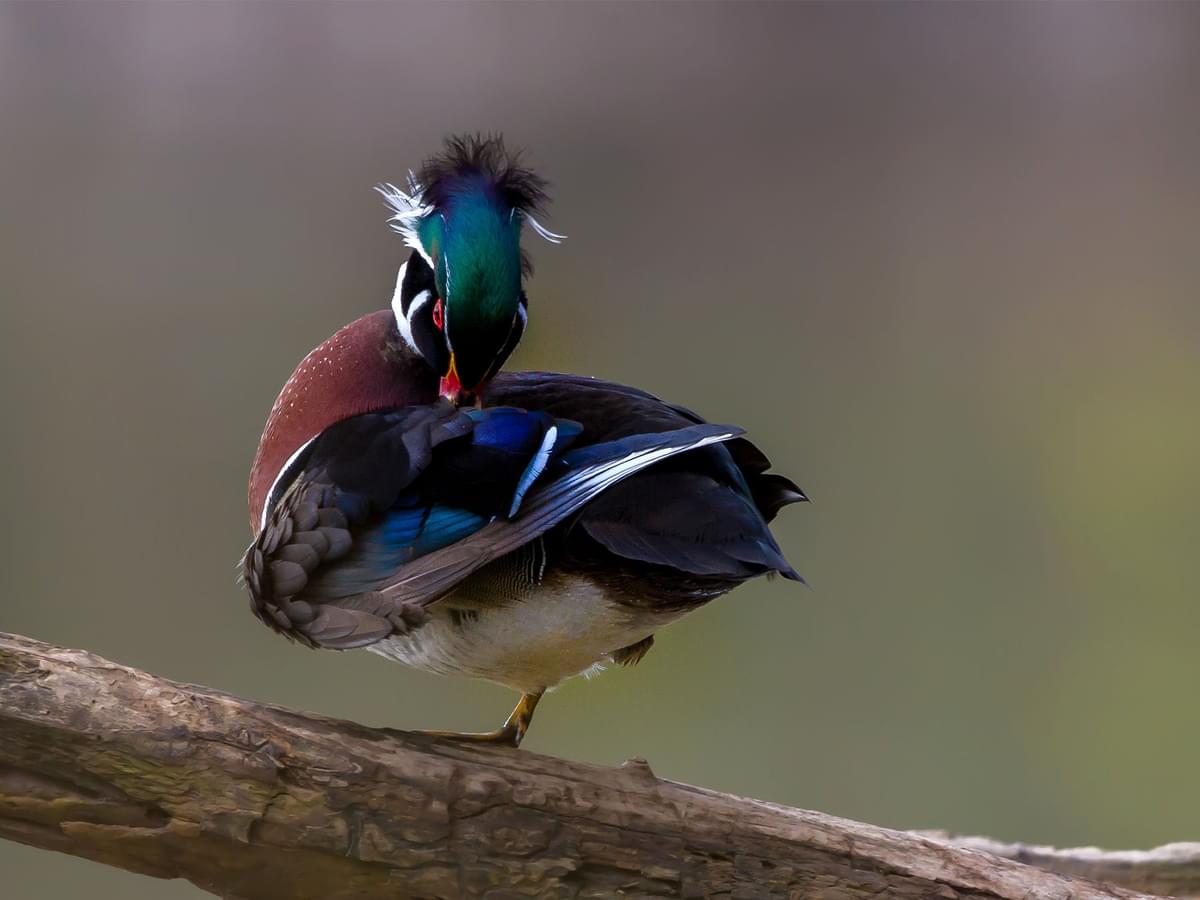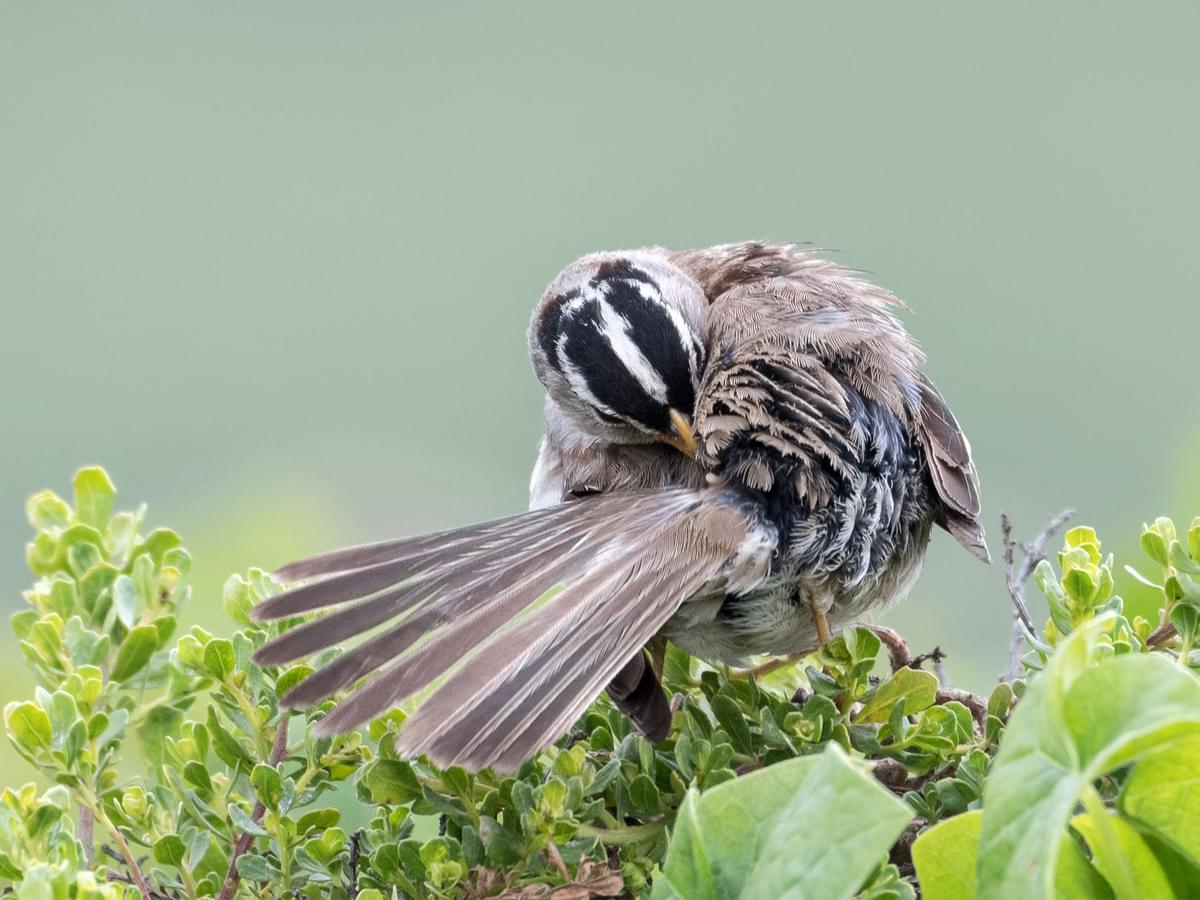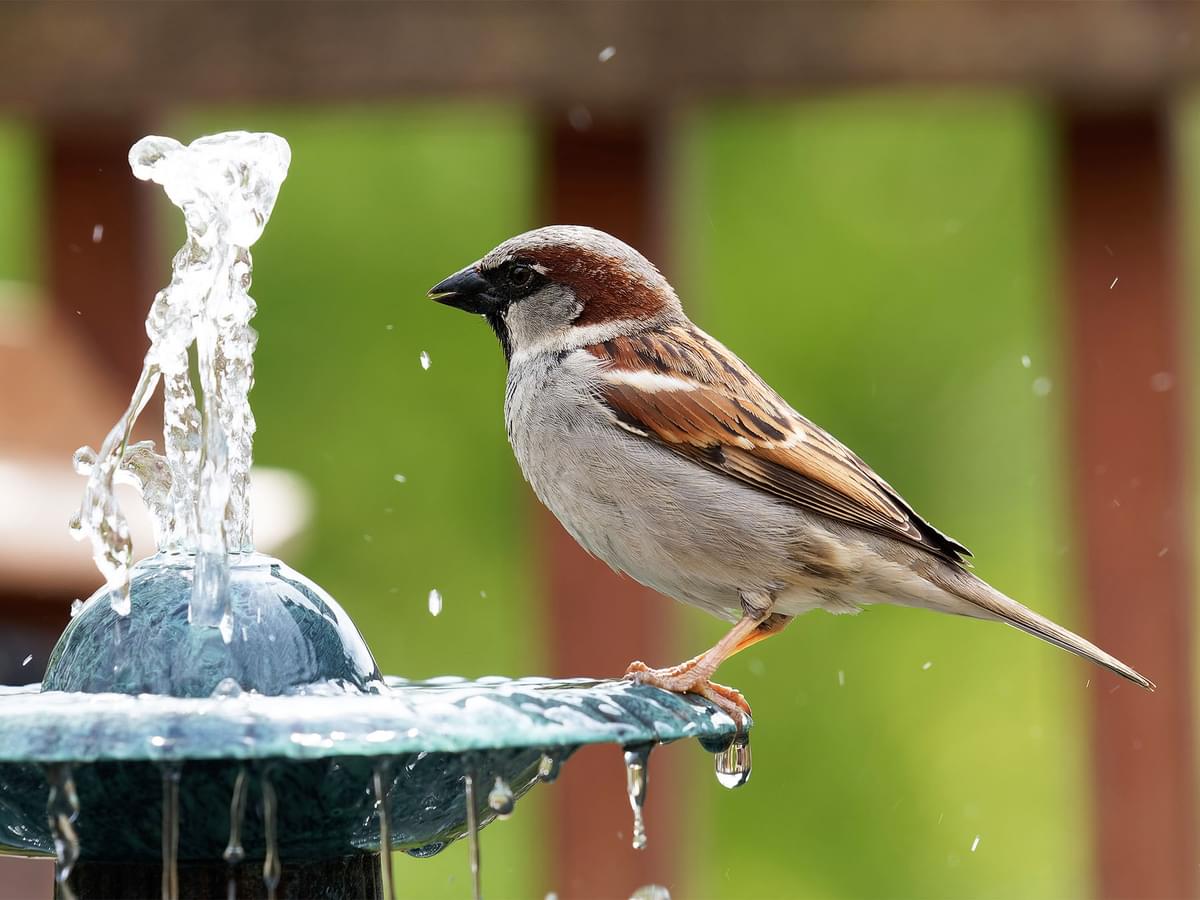Bathing & Preening
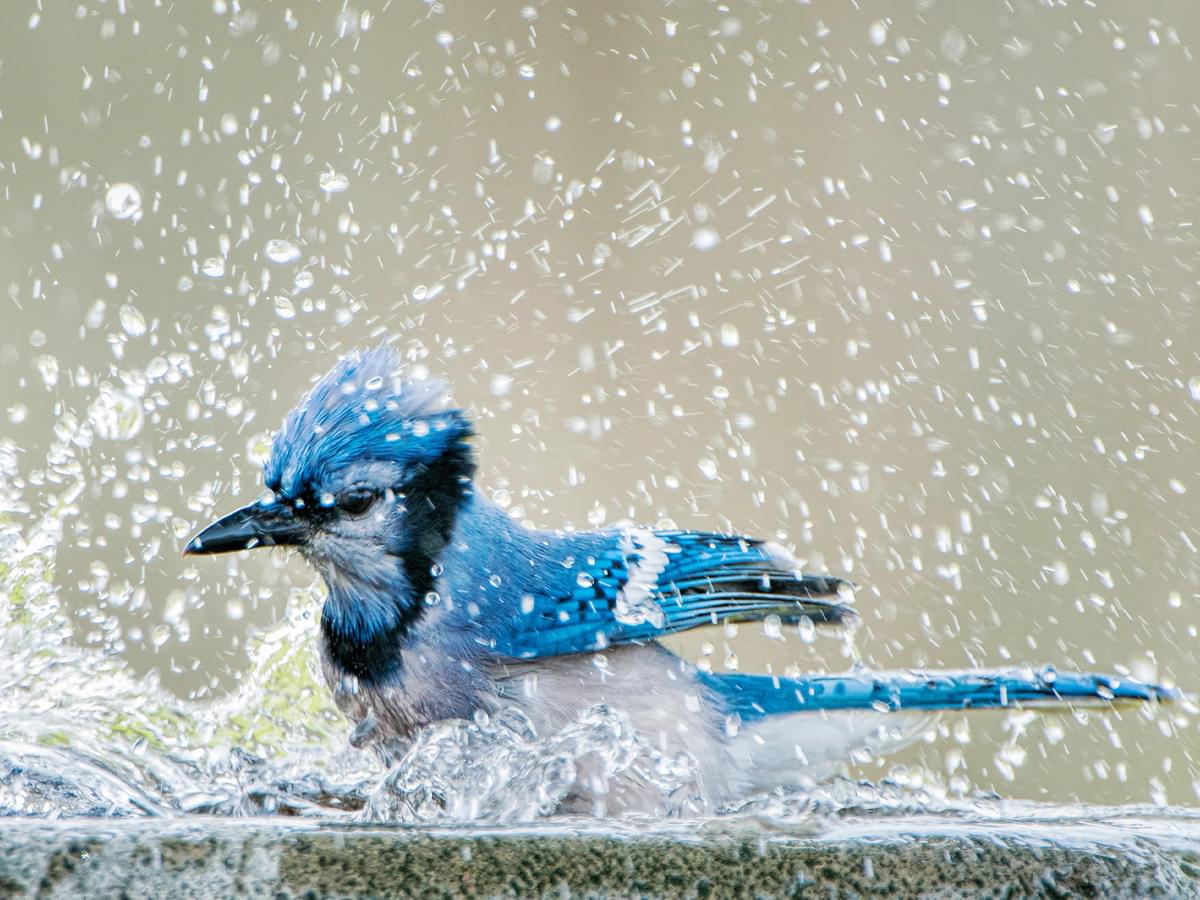
Overview of Bird Bathing & Preening
The Art of Bathing and Preening
Roughly 10,000 species of birds inhabit the earth, living everywhere from downtown city streets to the frozen desert of Antarctica. Feathers are one of their many secrets to success, but these unique avian structures are not maintenance-free.
Birds must bathe and preen regularly to keep their feathers in good shape, control parasites, and look their best. These behaviors are vital for their survival because out-of-place feathers hinder flight and render birds vulnerable to cold and waterlogging.
In this guide, we’ll introduce the interesting world of bird bathing and preening, two behaviors you’ve probably seen countless times without giving much thought.

Pictured: A Gray Catbird. Birds must bathe and preen regularly to keep their feathers in good shape
The Importance of Bathing & Preening
Health and Hygiene
Birds are perfectly adapted to their environment, but they are not immune to parasites and diseases caused by poor hygiene. Regular bathing and preening remove accumulated dust, oils, dirt, and parasites on their feathers and the skin between them. Over and above the hygiene benefits, a nice bath also helps birds keep cool on hot summer days!
Feather Maintenance
All birds have feathers, and none can survive without these remarkable structures. They are used for flight, insulation, waterproofing, and many other vital functions, and plumage that is out of place, matted, or dirty will affect flight and thermoregulation.
Replaced just once or twice a year, a damaged feather will not regrow until the next molt, which makes frequent maintenance essential. To keep their plumage in good shape for up to a year requires dedication, so birds spend a fair chunk of their day meticulously fussing over their feathers.
Birds bathe in both water and dust to maintain their plumage. This helps to manage the oils on their feathers to keep them from becoming too greasy and matted. They preen to reapply protective oils, keep their feathers in position, and keep each barb and barbule locked in place.

Pictured: A pair of Eastern Bluebirds. Birds bathe in both water and dust to maintain their plumage
Bird Bathing Behaviors
Types of Bird Baths
Birds have evolved various bathing strategies to suit their physical characteristics and the habitats where they live. In this section, we’ll look at a few common bathing behaviors.
Typical bathing
Most small to medium-sized birds with well-developed legs bathe standing in shallow water up to a few inches deep. They will use any standing or slow-flowing water, including bird baths, blocked gutters, puddles, and the edges of rivers and lakes. Even large leaf surfaces make a handy bath for birds in tropical regions.
Dipping and diving
Agile flying birds like Swallows, Martins, and Swifts bathe while flying by diving into water for just a moment before continuing their flight. Flycatchers will splash into the water from a nearby perch and then return.
Showers
Some birds, like Woodpeckers and Hummingbirds, are not particularly comfortable on the ground or as agile in the air as swallows. These birds love to bathe in the rain when they can, although they will also use standing water.
Open Water bathing
Despite spending so much time in the water, shorebirds, seabirds, and wildfowl also bathe, either while floating, standing in the shallows, or by submerging beneath the surface.
Dust baths
Birds also bathe in dust, either when water is unavailable or by preference. Dustbathing birds lie down on their bellies in dust or other fine, sandy substrates and shake themselves from side to side to encourage dust to go between their feathers. Some birds bathe in water and then dust in sequence.

Pictured: An Ostrich having a 'dust bath'
Anting
Although not quite the same as bathing, no discussion on bird hygiene would be complete without mentioning anting. This is the fascinating behavior of many birds that rub themselves on ant colonies to provoke ants into releasing formic acid onto their plumage.
Many birds also pick up individual ants and rub them on their feathers. The secretions from the ants are thought to deter parasites. Pretty smart!

Pictured: An Eurasian Blackbird anting
Bird Bathing Rituals
Most songbirds enter shallow water, fluff out their feathers, flick their wings, and twist their necks from side to side to get water in between their plumage and onto their skin. They also dunk themselves under the water to get their backs wet. However, birds like swifts that dive into the water don’t have the time for these ritualized movements, so they arch their tails upwards to direct a spray of water over their back.
Once bathing is complete, birds dry themselves with rapid movements to shake water off their feathers and encourage water and dirt out from between them. Birds like Anhingas and Cormorants stand out in the sun with their wings spread open to speed up the process.
Birds bathe very regularly, often several times each day in warm weather. We can all agree that a nice cool dip is great on a hot day but not very pleasant when it’s cold out! After bathing, most birds move on to preening. Continue reading to learn more about this vital process.

Birds like Anhingas (pictured) and Cormorants stand out in the sun with their wings spread open to speed up the drying process
Bird Preening Behaviors
The Preening Process
Preening is the process of caring for and maintaining feathers. Birds do this to remove parasites, clean their fathers, keep them in position, and coat them with preening oil.
This waxy substance is produced in the uropygial gland, which opens up at the top of their tails, just above where their rectrices (tail feathers) start.
Preening oil is wax-based and made of fatty acids that keep feathers from becoming dry and weak. It does not create a waterproof layer in itself but rather maintains a bird’s naturally water-tight feather structure. Evidence suggests this oil may be useful for controlling pests and harmful bacteria.
Birds reach back to access the uropygial gland and collect oil on their bills before applying it to their plumage. While preening, birds work from the base of each feather, gently wiping or ‘chewing’ with their bills to apply the oil, manage their feather structure, and kill parasites. Sometimes, they may need to pull on their feathers and bend them quite vigorously to achieve the desired result.
As flexible as birds may be, they cannot apply preening oil to their head with their own bill, so they either rub their head directly on the gland or transfer oil from their bill to their feet and then onto their head.

Pictured: A Puffin preening. Preening is the process of caring for and maintaining their feathers
Preening Variations
Birds devote varying amounts of time to preening depending on their species, with some spending as much as a quarter of their day engaged in feather maintenance. Birds may also preen at night, both while awake in moonlit conditions or even at intervals between sleep. Most birds will preen while perched, but water birds can preen while swimming, and swifts can preen in flight.
Special Cases
Diving birds require particularly frequent preening to stay waterproof, while flightless groundbirds from warm, dry habitats require relatively little feather maintenance. In fact, birds like Ostriches do not have a uropygial gland and rely largely on dust bathing to maintain their feathers. Some small flying birds, including various Pigeons and Parrots, also lack the preening gland, although they still preen regularly.
Other preening functions
Some birds preen their partner as a bond-strengthening behavior, while gregarious species may preen other members of their flock to socialize and maintain their dominant structure. Birds also preen as a comfort or displacement behavior. A stressed bird may perform compulsively after a stressful event.
Rousing
Birds also manage their feathers without using their bills or feet. Rousing is a common behavior where birds raise their feathers, shake vigorously, and then lower them. This is a quick fix for getting all their feathers back into position.

Pictured: A pair of Jackdaws preening each other. Some birds preen their partner as a bond-strengthening behavior
Summary
Bird bathing and preening behaviors are every bit as important as feeding, reproducing, and other vital functions. After all, what’s a bird without its feathers?
Observing preening and bathing opens up fascinating new opportunities for birdwatchers to learn about avian behavior.
Next time you’re watching backyard birds fly in to visit your bird bath or observing wild birds out in the countryside, keep an eye out for these behaviors - you might be surprised how much you’ve been missing!
Recap
- Birds bathe and preen primarily to maintain their feathers and reduce their parasite load.
- They need their feathers to be in perfect working order for flight, waterproofing, and keeping warm.
- Feathers do not grow continuously and are only replaced once or twice a year, so regular maintenance is vital.
- Birds usually bathe and preen every day, sometimes multiple times, and for extended periods.
